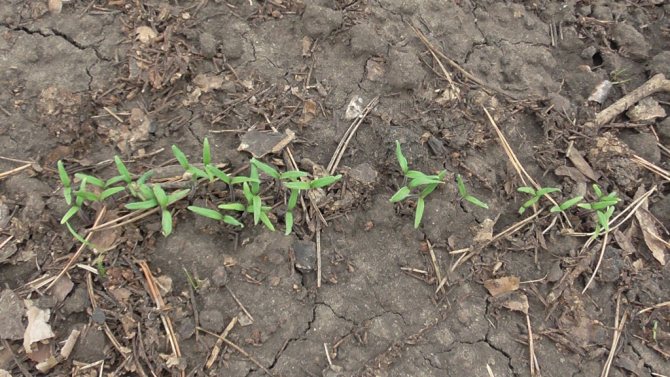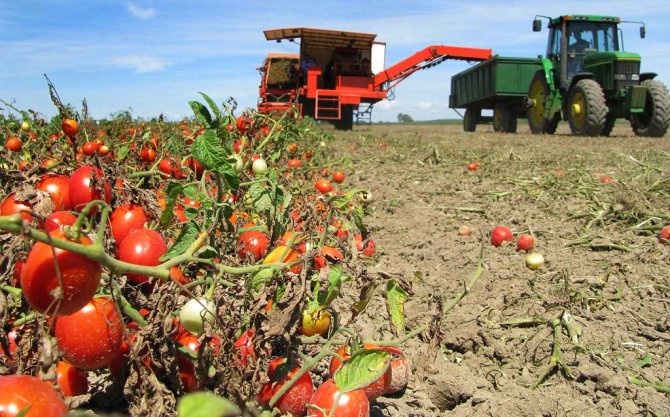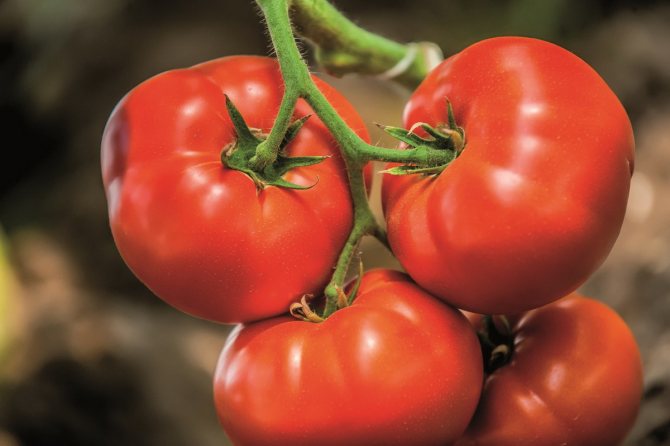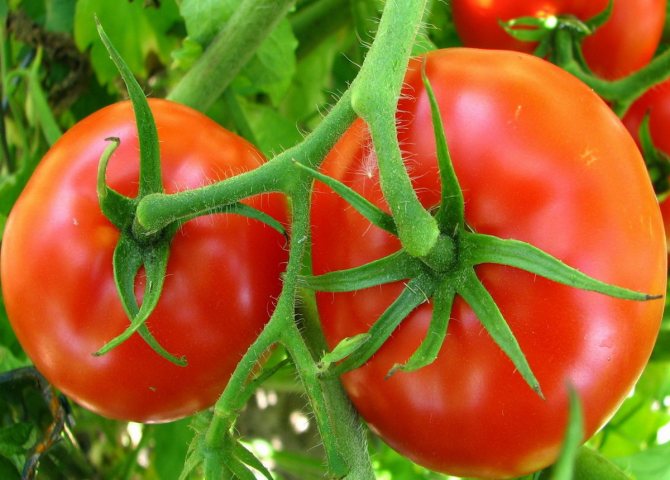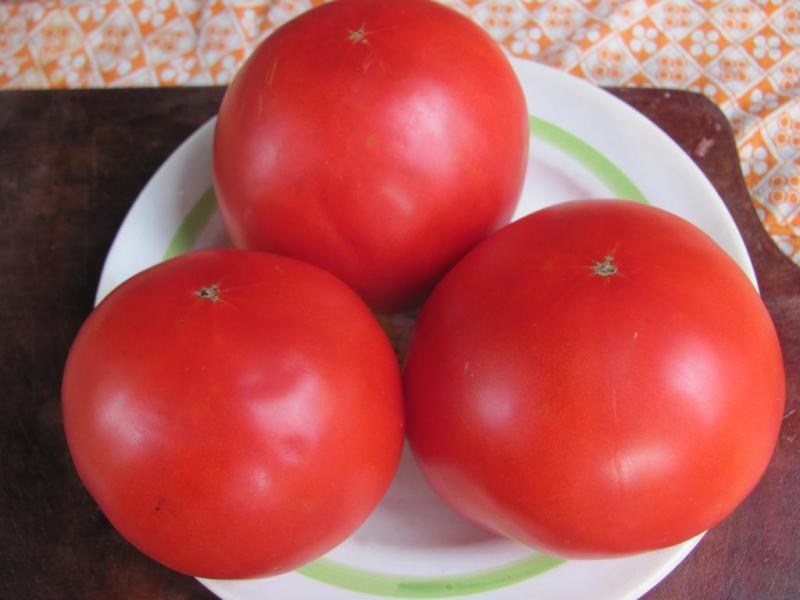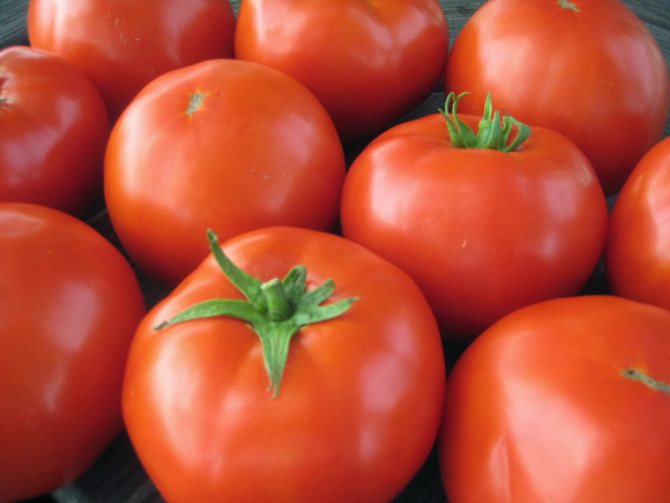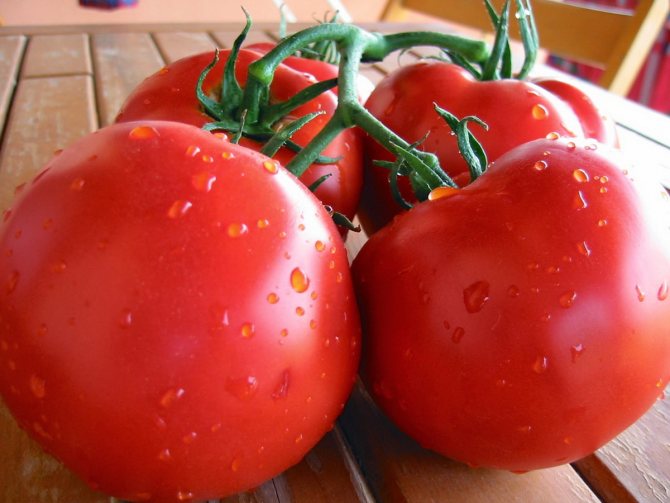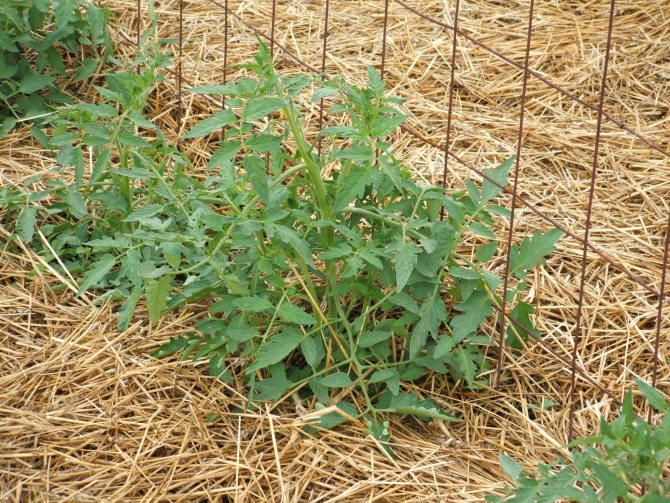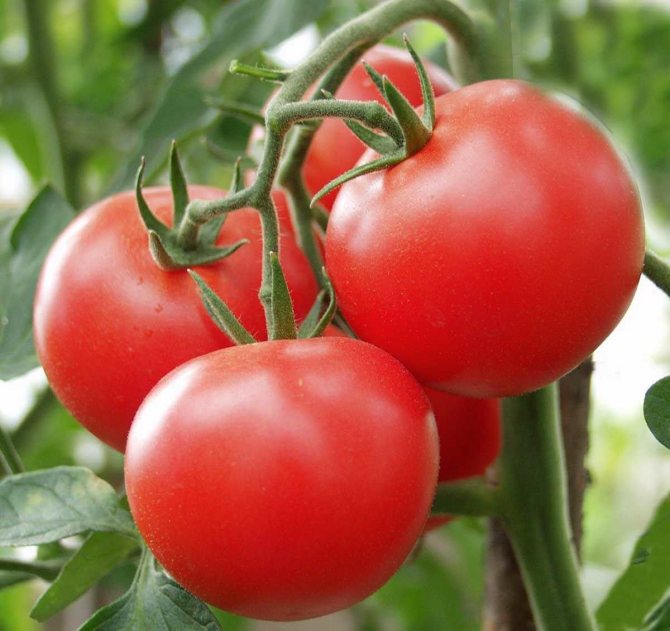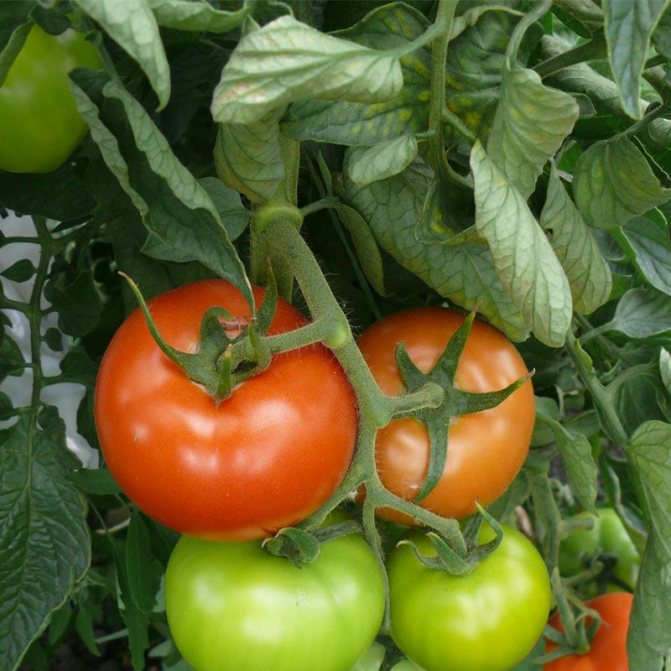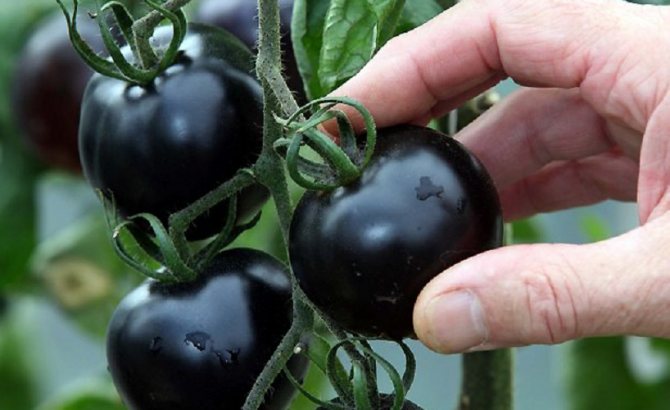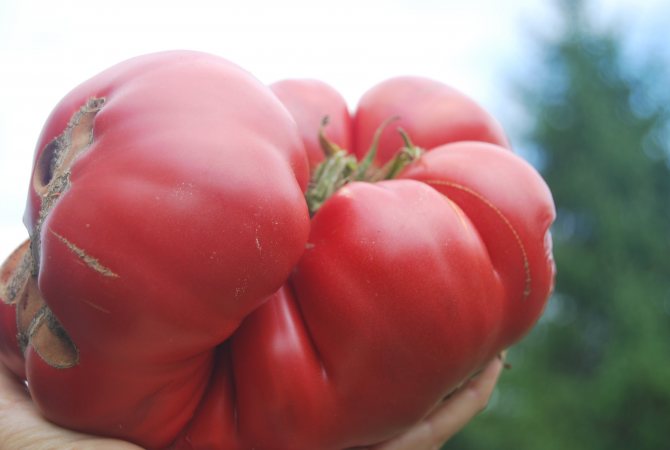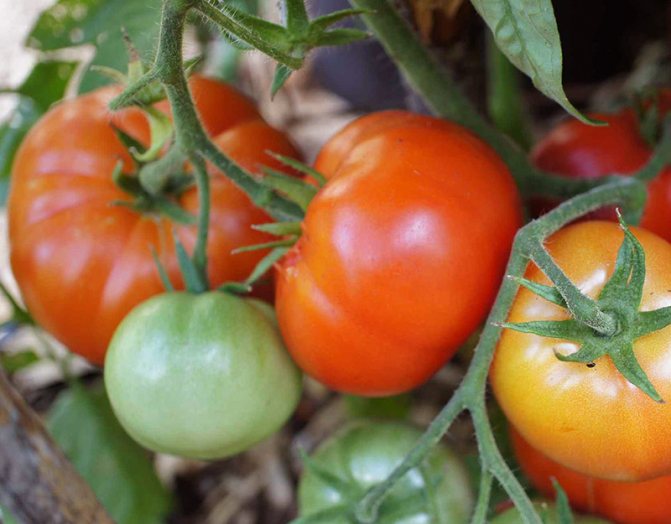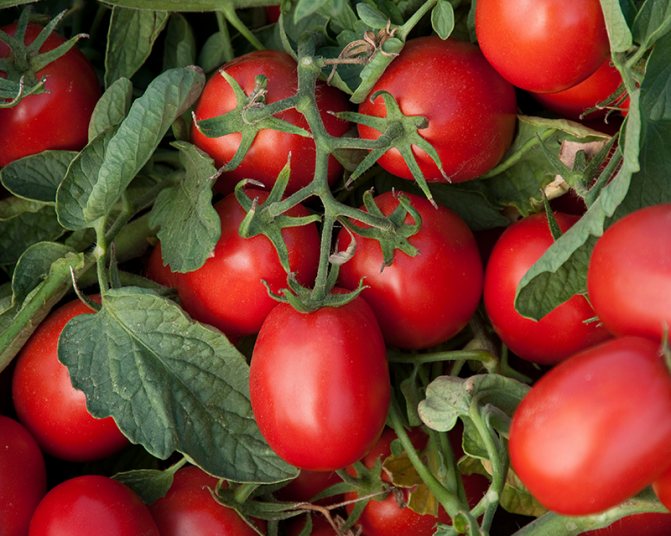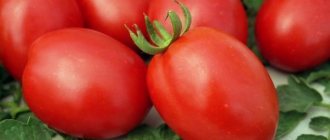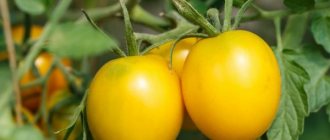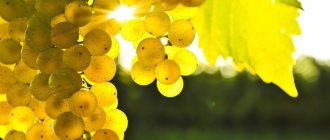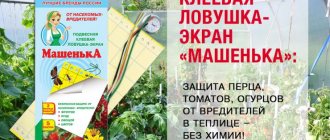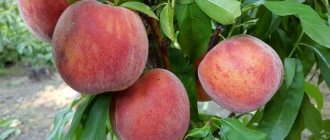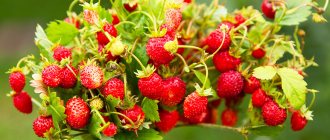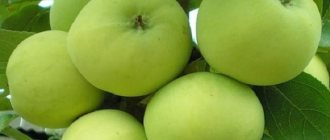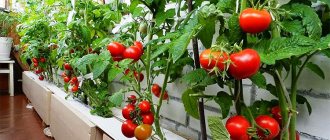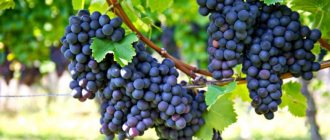Features of growing tomatoes in the Krasnodar Territory
Summer is very hot there. The summer resident should remember this when choosing the types. It is better to choose tomatoes that are resistant to high temperatures and strong sun. For planting, zoned species are used. It is advisable to choose varieties that have wide leaves, vegetables grow under the cover of a powerful green mass.
Krasnodar Territory is very large, the Kuban River divides it. Each part differs from the other in climatic features. The northern part is characterized by an arid climate. And in the mountainous southern part, precipitation often falls, so the climate is more humid, similar to the Stavropol Territory.
In the southern part, tomatoes are planted directly in open ground, and in the north they are grown using only the seedling method.
Asterix F1
The originator of the variety is the firm Syngenta (Switzerland).
This medium-ripening variety is suitable for you if you rarely visit the garden or dacha. Tomato fruits will await you in excellent condition even under the scorching sun.
The tomato plant is undersized, perfectly holds the shoots without snuggling.
The fruits of "Asterix" are suitable for salads, canning and processing into tomato products. Tomatoes are cylindrical, and the rib can be strongly and weakly expressed, moreover, on the same plant. Tomato weight 85-95 g. The high level of dry matter and sugars makes the taste very balanced and pleasant with an excellent tasting rating.
The Asterix hybrid has an excellent yield, higher than the standard level, and reaches 520 c / ha.
A high yield of marketable, aligned products, up to 95%, puts the hybrid at the top of the ranking.
Advantages:
- heat resistance;
- yield;
- great taste;
- resistance to nematode, fusarium, verticillium.
Good heat-resistant varieties, which are included in the register and have proven themselves excellently as heat-resistant varieties of tomatoes, were created by French breeders. Among the best are:
The best varieties for the Krasnodar Territory
You can grow tomatoes in any conditions. Breeders develop adapted varieties that can grow in a wide variety of climatic conditions.
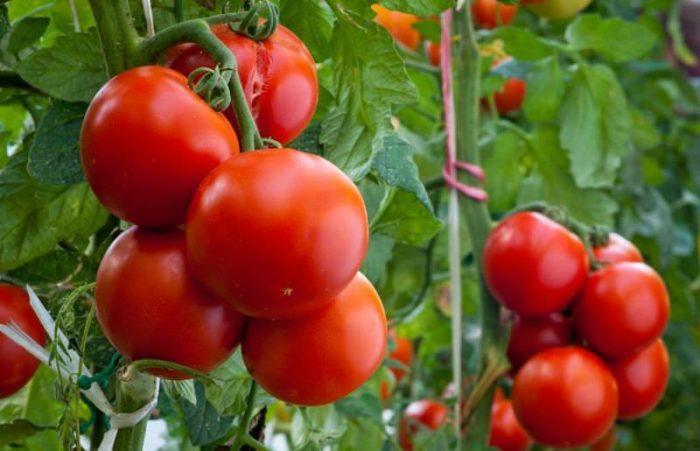
Early cycle tomato varieties
Early types of tomatoes are grown by summer residents everywhere, regardless of the region of residence. Sweet Kuban tomatoes are appreciated by vegetable growers. This plant is a must for growing in any area.
Riddle
Tomatoes are ready to eat in 85 days, depending on the care. The fruit is characterized by the presence of acid in the taste. The color of tomatoes is pronounced red. 5-6 fruits are formed on one hand. Bushes are low, 0.5 m, powerful and large stems. Stealing is practically not required, and a garter to the supports is not needed either. Plants are immune to many diseases.
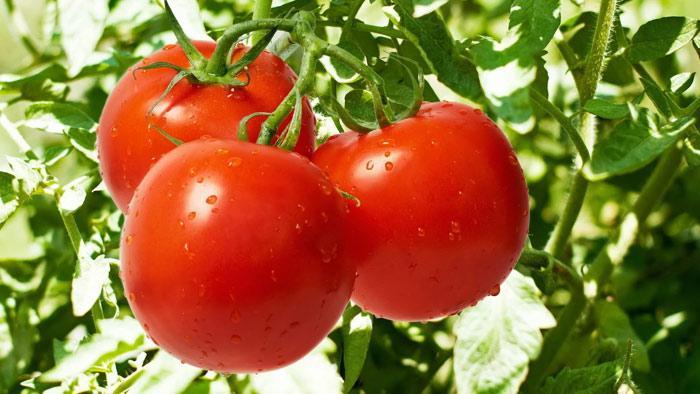

Chinese
Versatile tomatoes are suitable for any type of consumption and application. Ripen within 90-100 days after planting. There are a lot of fruits on the bushes, the yield is high. Especially if the stepsons are removed correctly. Bushes are low, strongly leafy and unpretentious. The Chinese variety is very hardy and disease-resistant.
Anastasia
Tomatoes form 5-7 tomatoes in clusters weighing 200 g. Fruits are red; they do not differ in taste.A small green spot is formed near the stalk, which will remain in its mature form. With proper care, one plant produces 10-12 kg of tomatoes. It is unassuming in leaving, resists late blight.
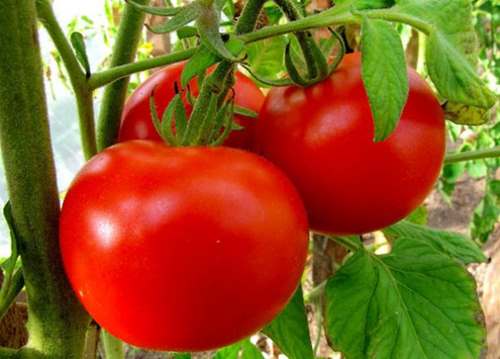

Persimmon
The orange fruit has a sweet taste. The yield per plant is 5 kg. Tomato weight 200 g. Ripens in 115 days. It branches weakly, but because of the strong foliage, it hides fruits well from the sun.
Salute or fireworks
The peculiarity of the variety is its decorative effect. At the same time, mature fruits grow on 1 brush, new ones are poured, an ovary is formed, flowers bloom. Tomatoes are plum-shaped, bright yellow shade. Fruits are used for any application. The height of an adult bush reaches 0.8 m, it resists the tobacco mosaic virus.
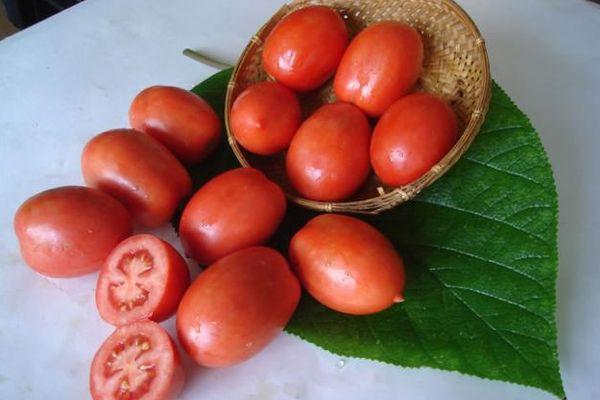

Crimson giant
Tomatoes are of different sizes, the maximum weight is 650-700 g. Ripe pink fruit. The main purpose of the vegetable is fresh consumption. Housewives use it to make tomato paste and other processing methods. Depending on the correct care, 10-11 kg of tomatoes are obtained from 1 bush. Plants form 2-3 stems. The Raspberry Giant tomato is immune to common crop diseases.
Kubanets
The hybrid is immune to disease, able to grow and bear fruit under adverse conditions. The Kuban man endures stress much easier than other fellows. Tomatoes are small, weighing 100 g. From 1 plants are harvested up to 4-5 kg of tomatoes. Responds positively to feeding.
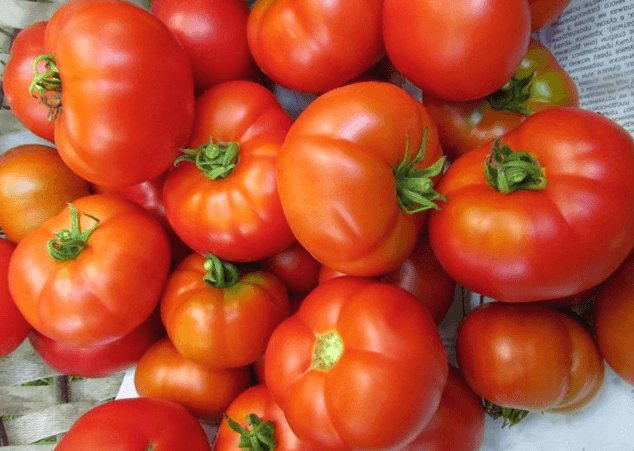

Tomato varieties of the middle and late ripening cycle
Tomatoes ripening in August are used fresh and for winter harvesting. Summer residents select varieties that satisfy the needs of the family.
Doo karao
Color variety of fruits:
- red;
- pink;
- the black;
- yellow.
See also
Diagram of the correct pinching of tomatoes in the greenhouse with your own hands
To read
Tomatoes are used mainly for canning. The reason is the small size and high density of vegetables. The bushes are tall, if the growth point is not removed, the plant reaches a height of 3.5 m. When heat treated, the structure of the fruit is preserved. Immunity in tomatoes is average. The yield is 8.5-9 kg. Up to 12 fruits are formed in one cluster.
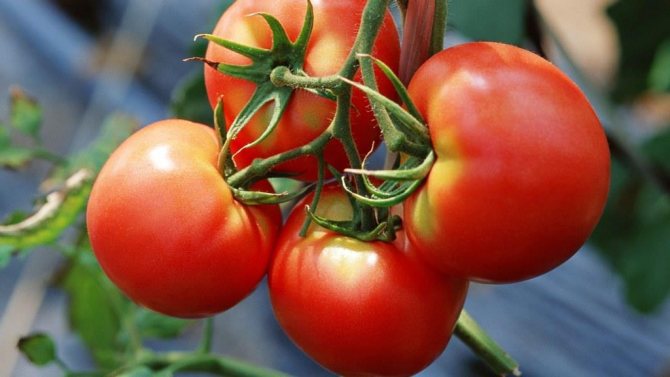

Tsifomandra
It grows up to 2 m, has a powerful stem and a strong root system. Distinguish:
- Rotamer, its fruits are sweet;
- Inka Gold, aftertaste reminiscent of apricot;
- Solid Gold, this variety is used for making soups and purees.
When the necessary requirements of agricultural technology are fulfilled, 9 kg of vegetables are harvested from one plant. They are used for any purpose. The field health of the bushes is high. If you transplant the bush into a container and bring it into the house, Tsifomandra will bear fruit in winter.
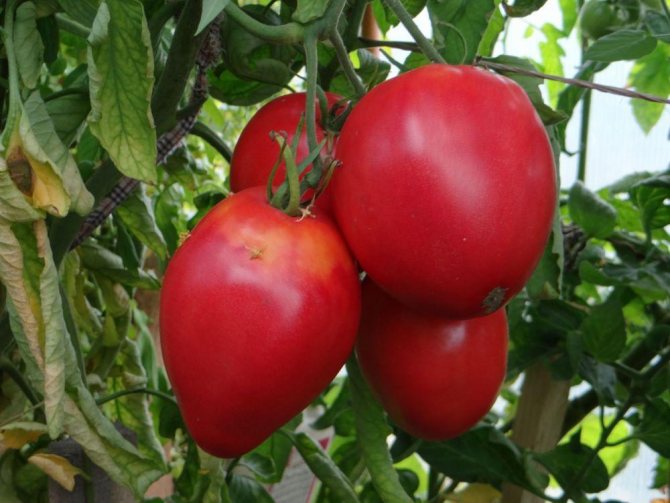

Gift of the Kuban
The plants are very leafy, the fruits are ready for use 115-125 days after planting. Fruits do not crack when ripe. The variety resists rot. Undemanding in leaving. Productivity is 5 kg per plant.
Lemon-liana or Wonder of the World
The size of an adult plant is 2 m. In shape and color, the vegetable resembles a lemon. Maximum 1 tomato weighs 100 g. Ready to eat 125 days after planting. This variety has a high immunity to crop diseases.
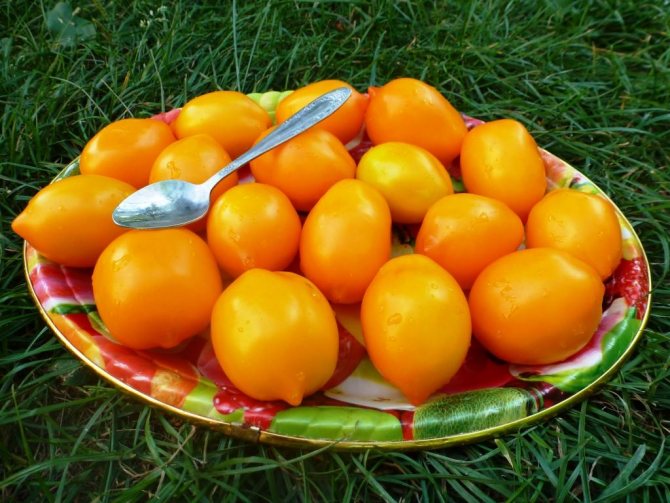

Giant of the East or Giant Pink
Vegetables weigh 450-500 g, excellent taste characteristics, shade of pink. The plant reaches a height of 2 m. Summer residents recommend pinching the bushes.
Tiger
The variety got its name due to the unusual coloring of the tomatoes. They are dark pink in color with yellow stripes. The weight is small, the maximum tomato weighs 60 g. The ovary is formed in the clusters, from 9 to 12 tomatoes ripen on one. When all the requirements of agricultural technology are fulfilled, 7 kg of tomatoes are harvested from 1 plant. Plant height 2.5 m.Due to its unusual appearance, it is used when pickling or preparing assorted vegetables.
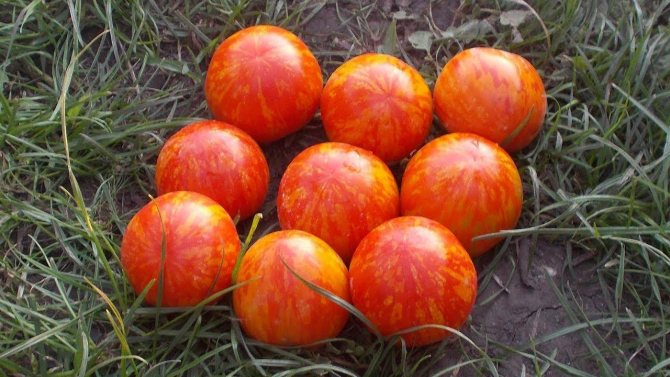

New product of the Kuban
Ripens 150 days after planting. The fruits are round. The weight of one tomato is 100 g. The total yield from 1 m2 is 7 kg. Bushes reach 40 cm in height. The appointment is universal. The approximate ripening time is 140-160 days. This view is used for bulk assembly. Disease resistance is average.
Russian giant
Tomatoes of this variety are used for processing or use for salads. The bush grows up to 2 m. Pinching is required. The mass of one tomato is 500-600 g. Compliance with the requirements of agricultural technology will help to get a good harvest. 1 plant produces 6 kg of tomatoes. Manufacturers note high immunity to diseases and resistance to pest attacks.
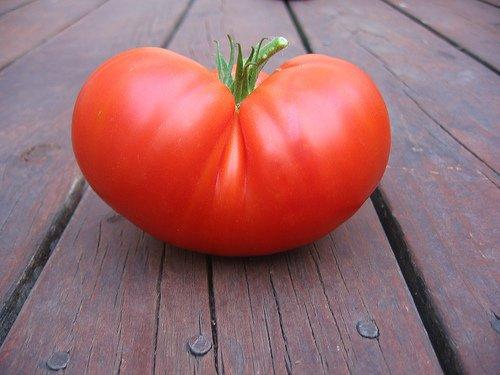

Universal varieties
Such varieties that are grown both in greenhouses and in the beds are in no less demand among summer residents. Such species give a bountiful harvest and are able to grow in any conditions.
Giant yellow
Early tomatoes, yellow. They weigh 200-300 g. They are used for all methods of winter preparations, preparation of salads. The height of the tomatoes is 1.5 m. Summer residents recommend forming a bush in 2 stems. Tomatoes are ready to eat in 120 days. 5-6 kg of fruits are obtained from 1 bush.
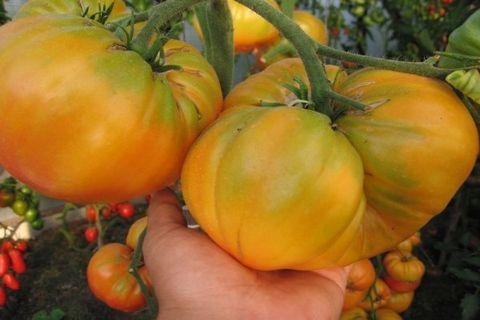

Bull heart
A common type of tomato, familiar to summer residents for a long time. The fruits are appreciated for their meatiness and sweet taste. The average weight is 350-400 g, some specimens reach 550-600 g. The height of the bushes reaches 1.5 m. With the correct formation and implementation of agrotechnical techniques, 10-15 kg are obtained from 1 bush. The color of the fruits of this variety is different, depending on the subspecies. The main purpose is fresh consumption.
Giant Novikov
The height of the bushes reaches 2 m. The fruits weigh about 1 kg. Carry out pinching and garter to the supports. Particular attention is paid to the fixation of fruit brushes. Tomatoes of huge size, with proper care, allow you to collect 20 kg of fruits from 1 bush. The rest of the plants are unpretentious, respond well to feeding. To increase the yield, they are formed into 1 stem.
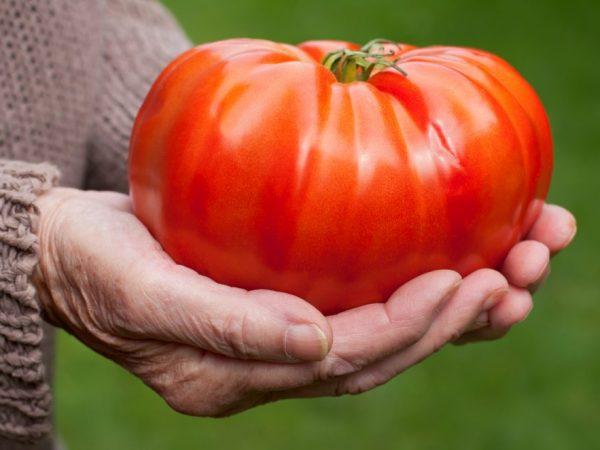

Black Prince
The peculiarity of the plant variety is that it bears fruit for a long period. Tomatoes weigh 300 g. The height of the bushes is 1.8 m. The yield of 1 plant is 8 kg. Average immunity, resistant to pests. The stepsons must be removed.
See also
Types of structures for automatic irrigation in the greenhouse and how to do it yourself
To read
To increase the size of the fruit in the open field, remove the growth point.
Crimson lamp
There are no peculiarities in plant care. Bushes are unpretentious and undemanding. Plant height 2.5 m. Competent care allows you to get 6 kg of tomatoes from 1 bush.
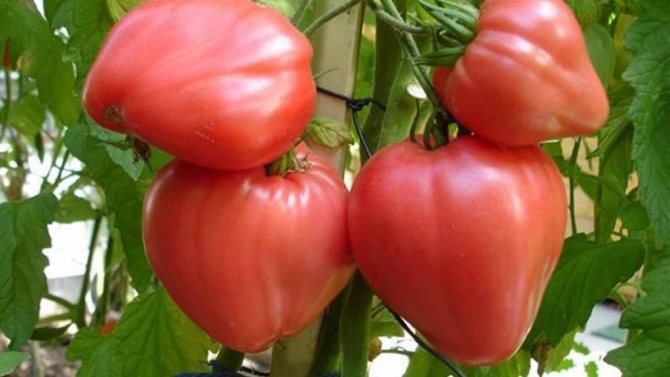

Hybrid tomato varieties
Tomato hybrids are in demand among summer residents. They are unpretentious, hardy and very productive.
Merchant's wife F1
The variety is famous for its heat resistance, unpretentiousness and high immunity. Tomato weight 250 g. The purpose is universal. Ripen in 90 days. Productivity 4.5-5 kg from 1 plant.
Openwork F1
This variety is used for growing on an industrial scale. The reason is that when optimal conditions are created, the fruits retain their presentation and taste for up to 3 months. Plant height 0.8 m, yield 3.5-4 kg. The weight of one fruit is 300 g. Unpretentious bushes of the variety practically do not require maintenance.
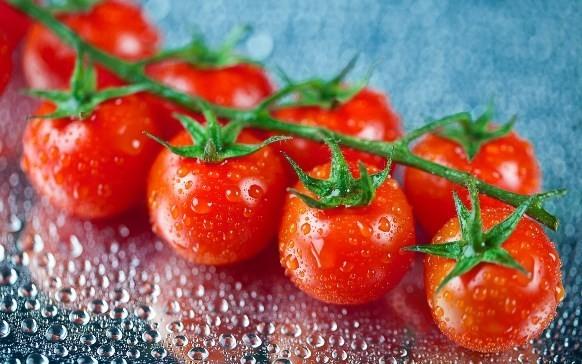

Fat F1
High immunity makes it a favorite for many summer residents. Plants are low, 0.8 m, powerful stems. Fruits 250-300 g, tasty and versatile in use. The fruits ripen within 115 days. The hybrid is unpretentious and undemanding to care for.
Bourgeois F1
The versatility of the use of fruits makes this variety popular among those summer residents who make massive harvests for the winter. Fruits are medium-sized, weighing 200 g. The plant reaches a size of 1.2 m.
Barin F1
Plants have high immunity, fruits are used for any purpose. Formation is practically not required. The height of the tomatoes reaches 0.8 m. The tomato weighs 250 g, the yield is 9 kg per 1 m2.
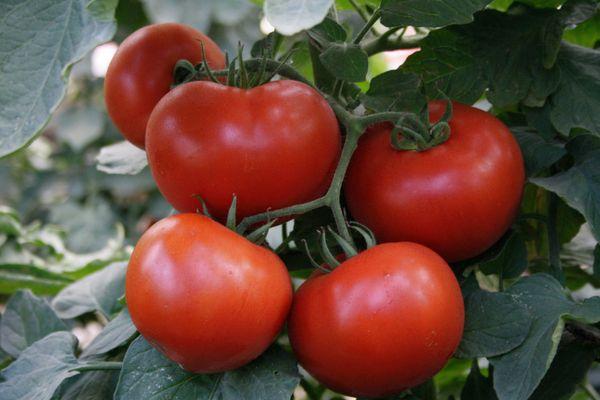

"Adelina"
The variety was produced by the agro Moscow region. Having planted this tomato, within 80 days after full germination, you will be able to consume its fruits.
The plant is early and undersized. The high yield, up to 500 c / ha, and the maximum one showed 669 kg, does not allow the tomato to grow without fixation and rationing.
Fruits are ovoid, smooth, even, red, rich in color. The weight of one fruit is up to 100 g (60-80 g).
Having enjoyed the salad products having such a variety on the site, you can proceed to the blanks. "Adeline" perfectly tolerates thermal procedures. It is good for whole-fruit canning, pickling and pickling, it makes excellent tomato products.
Since the variety was bred for commercial production, the fruits have excellent transportability, and the ability to get to the processing sites without losing their organoleptic qualities.
Advantages of the variety:
- high productivity;
- high yield of marketable products (up to 84%);
- high heat resistance;
- resistance against a complex of diseases.
Varieties suitable for growing in garden beds
It is desirable to grow in open ground such varieties that are universal. It is advisable to plant hybrids, they are hardy, productive and undemanding to care.
You should choose from varieties:
- Bourgeois;
- Giant Novikov;
- Gift of the Kuban;
- Kuban and other varieties.
When grown outdoors, it is necessary to choose varieties with a highly leafy system.
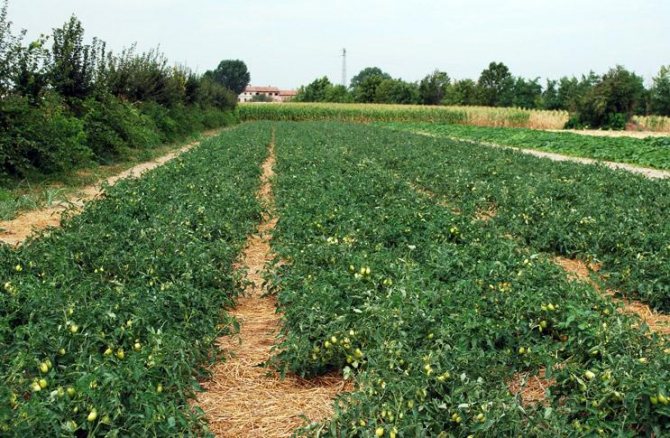

"Hector F1"
The tomato is of medium ripening. Suitable for fresh consumption, pickling, preservation and the manufacture of tomato products.
The low-growing plant form gives round, dense, with a weak rib, fruits of a rich red color.
Tomatoes are not large, up to 100 g, leveled, with very high taste.
Having prepared juice or tomato sauce, those who have already fallen in love with "Hector" note a special taste and a bright, rich color.
The yield of the hybrid is also not small, at the level of regional standards, but a high marketable yield improves the performance of the hybrid.
"Hector" is very resistant to a complex of diseases, which helps him to keep the stock under any circumstances.
Which varieties are best suited for indoor use
The summer resident should make a choice between hybrids, universal varieties, since the plants of these varieties are most suitable for protected ground. When choosing, you must study the description.
Types for greenhouses:
- Giant Novikov;
- Raspberry lamp;
- Black Prince;
- Bull heart and others.
Summer residents, observing the technology of care and planting, receive the declared harvest.
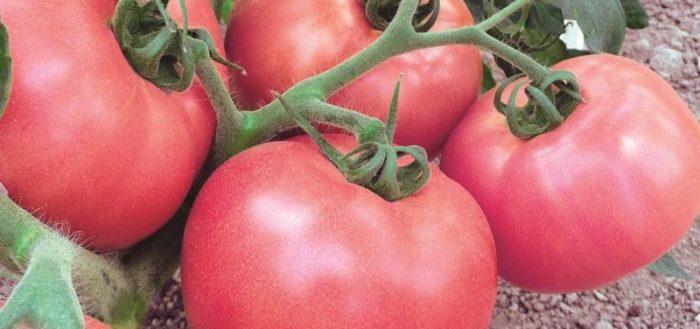

Heat-resistant varieties
For the Krasnodar Territory, it is these species that will help to harvest tomatoes.
These include:
- Adeline;
- Maestro;
- Pink andromeda;
- Asterix;
- Orpheus and others.
Petrarossa F1
Also a French hybrid designed for open field gardens of amateurs and farmers.
The tomato is universal. Its fruits have excellent salad properties, suitable for canning and processing.
Hybrid not very early, giving determinant obovate tomatoes with smooth, dense barrels. Tomatoes are saturated, red.
Weight from 60 to 100 g, which bestows on "Petraros" the most necessary. These fruits can be used for all culinary delights.
Tomatoes have a high content of dry matter and organic sugars, but acids are in such a balanced ratio that their taste is barely perceptible, but significantly improves the taste of all tomato products.
The hybrid shows the yield even with anomalous dry land at the standard level.
Tomato advantages:
- heat resistance;
- product yield (95%);
- disease resistance.
Growing and caring for tomatoes in the Krasnodar Territory
Getting a high yield depends on the hard work of the summer resident. It is important to follow simple recommendations, and the plants will be rewarded with fruits.
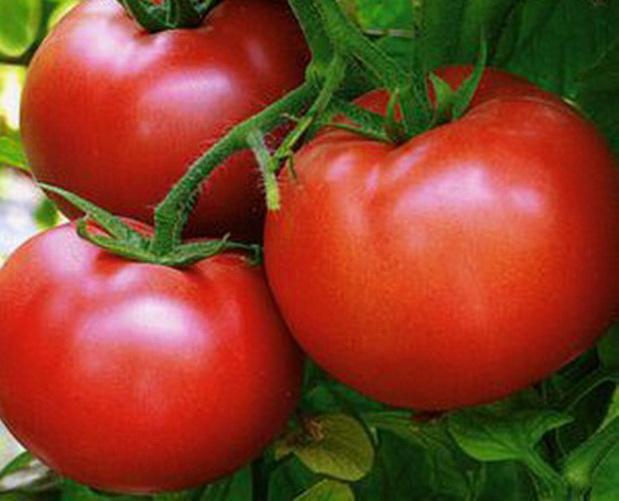

For open ground
You need to know exactly when to sow tomatoes for seedlings. Optimal terms: end of March - beginning of April. Growing strong planting material will allow you to get a good harvest of fruits.
Planting tomatoes is easy, you need to prepare containers, fill them with fertile soil and sow seeds in them.
Next, monitor the growth of seedlings, as soon as you are ready to organize a transplant to a permanent place.
For greenhouses
Seeds are planted directly into the ground, immediately to a permanent place. The seeds are sown in prepared grooves. Then they are watered and covered with polyethylene.
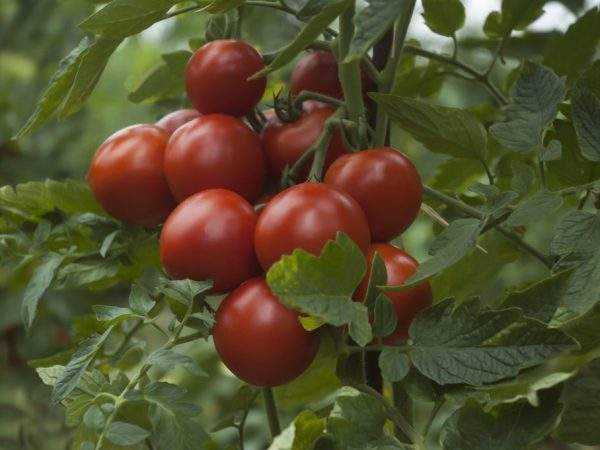

Planting tomatoes in a greenhouse is easy, you need to choose the right varieties.
"Amiko F1"
This hybrid was presented by the Netherlands, and since 2005 it has pleased vegetable growers and farmers, and gives a high yield of tomatoes.
Tomato early ripening. Suitable for salads, as well as for canning and processing. The plant is undersized, determinate, perfectly keeps its shape and fruits, weighing 70-90 g does not lie down even when not tied up.
The fruits are beautiful, even, cylindrical, uniform, not shallow.
The yield of the hybrid shows at the level of standards, about 450 kg / ha, but the fact that it proudly withstands the sun sets it above the standards.
"Amiko" is very resistant to fusarium, vertilly wilt, tobacco mosaic virus, cladosporium.
Advantages:
- heat resistance;
- resistance against a complex of diseases;
- great taste.
Plant care rules
Leaving is half the battle. To get a harvest, you need to carry out the following work:
- watering as the soil dries out;
- loosening or hilling, provides oxygen access to the root system;
- top dressing, as necessary, add humus or complex mineral fertilizers;
- shaping, pruning and pinching, removing unnecessary shoots leads to an increase in yield.
- garter to the supports, this applies to varieties above 0.9 m.
Leandra F1
This is another French variety that is striking in its resistance to abnormal heat, as well as to a number of tomato diseases.
Medium ripening variety, lettuce, determinant.
Flat-rounded, red-colored tomatoes have a smooth skin and a fairly dense texture. Tomatoes weighing 90-130 g have a very pleasant, balanced, tomato taste with an excellent rating.
Read also: Willow twig decor
Tomato yield is up to 775 kg / ha, which is much higher than standard varieties.
Advantages:
- yield;
- heat resistance;
- resistance to a complex of diseases.
The frequency of feeding
The first feeding is done immediately after planting the seedlings. This is necessary to reduce the adaptation period during transplantation. For several days, the bushes will get used to the new conditions of detention, the chemical composition of the soil.
The second is produced after the first small tomatoes appear. For intensive growth, the plant needs good nutrition. The time after landing here varies widely. Depends on the condition of the bushes, varieties, conditions of detention.
Next, you need to grow an excellent harvest, which will also require strength. The frequency at this stage is 10-15 days. It all depends on the depletion of the soil.
Seedlings need feeding most of all, they require a greenhouse climate, they are sensitive to watering and lighting. The seeds are immediately planted in the prepared soil, but there are stages of dressing that are recommended to be followed:
- The first - after the appearance of one or two full-fledged leaves.
- The second is after a dive.
- The third is before disembarking.
Seedlings are often grown in greenhouses, directly on the garden plot.This facilitates the transportation process, makes it possible to carry out the hardening procedure before planting.
In some cases, to protect the bushes from the sun, heat-resistant polycarbonate blocks or special filters are used that scatter sunlight, reduce the intensity of harmful ultraviolet radiation, and pass a certain color spectrum. They consist of heat-resistant materials that do not change their properties over time.
Fulfillment of certain rules of agro-industrial production allows you to get excellent tomatoes Novinka Kuban or another variety. All tomatoes are adapted for the difficult climatic conditions of the region and, with proper care, delight their owners with juicy, tasty fruits.
Otranto F1
The Netherlands gave the world another wonderful hybrid that should definitely be tried in those regions that are abundantly lit, and rains are rare.
This hybrid begins to bear fruit already when vegetable growers have already enjoyed the first, early tomatoes, and they have moved away.
"Otranto" is medium late, lettuce, undersized. Its large and dark green leaf covers the fruit so carefully that intense sunlight cannot have its scorching effect.
Tomatoes with a pronounced ribbing, red, flat-round, weighing from 75 to 125 g. The high dry matter content makes the fruit rich and moderately dense. Considering that there is not a large amount of sugar in a tomato, it seems that it will be sour, but its optimal ratio is so well balanced that, according to vegetable growers, it is very tasty, and the tasters rated it "excellent" for the true tomato taste.
The tomato yield is impressive, and even more so when many varieties burn out, and it shows a shaft higher than the standard by 68 kg / ha. Productivity of "Otranto" is within 700 kg / ha.
An excellent marketable yield of up to 97% allows you to save and sell the crop.
Salting
For lovers of tasty and juicy salted tomatoes, special varieties have been developed that can be grown in open areas. These include:
- Miracle of Vnukova. A mid-season variety that can be grown in a greenhouse or outdoors.
- Niagara. This variety is characterized by high yields. Since the height of the bush is large, tying is necessary.
- Wine jug. The culture is mid-season, tall. The tomato has an original shape.
- Watercolor. Harvesting can take place after 110-120 days. The plant is unpretentious to care for. The height of the bush reaches 50 cm. Garter and pinching is not recommended.
Types of heat-resistant tomatoes
Tomatoes are divided into two types according to their ability to withstand heat: vegetative and generative.
Vegetative bushes are heavily leafy, have numerous stepchildren. Normally, such bushes are planted no more than 3 per square meter, be sure to remove the stepsons. With the growth of stepsons more than 10 cm, no more than 60% of the fruits of the norm will be tied on the brushes of tomatoes of this type. But it is precisely these varieties that are able to provide the gardener with a harvest in hot weather and low humidity levels. Even when the leaves curl and burn, the foliage area is sufficient to protect most of the tomatoes from the sun.
The generative type of tomatoes has small foliage and few stepsons. These varieties are good for northern regions where their fruits can get enough sun to ripen. But the abnormally hot summer of the last few years has played a cruel joke on them. Fruits not protected by "burnt" leaves do not ripen, although initially the ovaries promise a good harvest. Non-ripening of fruits is due to the small amount of the antioxidant lycopene, which is synthesized in the temperature range from 14 to 30 ° C. Tomatoes do not turn red without it, remaining pale orange at best. Also, under such weather conditions, tomatoes develop apical rot.It is necessary to plant generative-type tomatoes at least 4 per square meter, trying to preserve as much foliage as possible on them. Sometimes even at the expense of leaving a couple of leaves on the pinched stepchildren.
But if you make a mistake, you can try to save the crop. At night temperatures not lower than 18 °, tomatoes are watered in the evening. Tomato bushes are shaded with non-woven fabric. If possible, a two-color film is placed on the beds with the white side up to preserve moisture in the soil and reduce the temperature of the soil.
When growing indeterminate tomatoes in a greenhouse, you will need to open the greenhouse as much as possible. If it is possible to remove the side walls, then they must be removed. The vents must also be opened and covered with non-woven material.
When choosing heat-resistant tomatoes, you can focus, if possible, on the appearance of the bush (whether the foliage protects the fruit) and the annotation of the manufacturer. Unfortunately, not all Russian firms consider it necessary to indicate on the packaging such an advantage of the variety as heat resistance. In this case, only an experimental clarification of the qualities of tomatoes is possible.
While scientists around the world are breaking spears, what awaits us in the future: global warming to unimaginable temperatures or no less global glaciation due to the Gulf Stream, which has changed its course due to the melted ice of the Gulf Stream, the flora and fauna of the Earth are forced to adapt to the annual "abnormally hot" summer weather. People are no exception. But if the townspeople can close in offices and apartments with air conditioning, then the gardeners have to not only work under the scorching sun in the beds, but also to select varieties of vegetables that can withstand such temperatures.
Most varieties of tomatoes, including foreign high-yielding hybrids, are not able to withstand high air temperatures. They usually grow at lower temperatures with little daily fluctuations.
Previously, heat-resistant varieties of tomatoes were of interest only to summer residents of the southern regions, where the air temperature sometimes could exceed 35 ° C, and even higher in the sun. Today, even the inhabitants of the Central strip are forced to plant these same varieties.
But at this temperature, good ovary formation is shown by varieties and hybrids from the Gavrish company.
In the case of a very dry and hot summer, when drought and stuffiness are added to the hot air, tomatoes get sick with vertex rot, the leaves curl and fall off. If the difference between night and day temperatures is too great, the fruits crack near the stalk. Such tomatoes rot on the vine. Even if they have time to ripen, they are no longer suitable for conservation and storage. Hybrids from, "SeDeK", "Ilyinichna", "Aelita" are able to withstand such conditions and give a harvest. Heat over 34 degrees for a long time leads to burns of fruits and leaves, as well as superficial roots of tomato bushes.
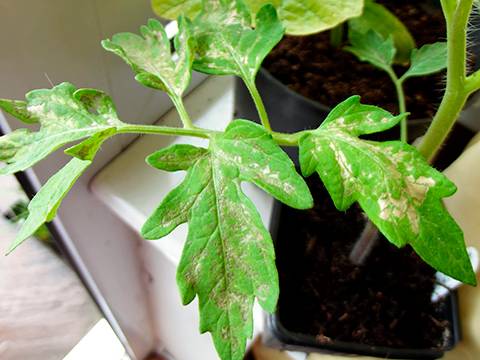

Tomato varieties specially bred for the southern regions are able to resist this problem. For example, Gazpacho from Gavrish.
You should immediately decide on the terminology. "Drought-resistant", "heat-resistant" and "heat-resistant" are not synonymous with plants. Drought resistance does not imply mandatory heat resistance. In the absence of rain, the air temperature may well be quite low and not exceed 25-30 ° C. A heat-resistant plant that can easily tolerate heat at 40 ° C can be very sensitive to the lack of water in the soil. The concept of "heat resistance" has nothing to do with living organisms at all. It is used to determine the ability of the materials from which structures are made to work at elevated temperatures without noticeable deformation. Steel may be heat-resistant, but not living wood.
Agrotechnics
As you know, tomatoes can be grown:
- using seedlings;
- using a seedless method.
Both have a business case.The arid climate presupposes the presence of seedlings and greenhouse conditions. Soft marine - native to tomato crops, here you can get by with sowing seeds in open beds.
The soil should be light, nutritious. A mixture of humus, sand and earth is ideal. Usually the soil is prepared in late autumn, scattering humus throughout the site. During the winter and part of the spring, it lays down, part of the nutrients is absorbed into the soil with the help of melt water. After that, complex fertilizers are added, dug up. It remains only to choose the right time for planting seedlings, take care of it and wait for the harvest.
The peculiarities of the soil in the Krasnodar Territory must be taken into account when planting. Arid steppe lands are composed of carbonate, leached chernozems. Mineral feeding is needed here.
Complex fertilizers are usually used - the risk of overfeeding the plant with a separate element is reduced. Sometimes there is a need for spot feeding of tomato varieties for the Krasnodar Territory - open ground allows you to apply fertilizers in a liquid or dry way.
For these purposes, they usually use:
- superphosphate (phosphorus content 20%) or double superphosphate (45%);
- potassium nitrate;
- urea.
To plant bushes in such soil, it is pre-treated with all three types of fertilizers. The recommended ratio is 1: 1: 1. After the appearance of the first fruits, the proportion is changed - 3: 9: 1.
The proportional composition of the fundamental elements in Krasnodar and the region is selected individually by region. The soil is different everywhere, after harvesting its composition changes greatly. The increase in the amount of potassium and phosphorus during the formation of fruits is due to the increased need of the culture for these elements. Fertilization schedules can be regarded as zoned - their composition varies over the entire area of the region.
The main thing is not to overfeed the plant. The increased content of nitrogen, potassium, phosphorus, magnesium leads to diseases, reduced yield, slowdown in growth.
Foliage is a kind of indicator of an increased concentration of elements:
- magnesium, phosphorus - leads to blackening of the leaves at the edges;
- nitrogen - yellowing;
- potassium - development of necrosis;
- calcium is a growth stimulant, the culture cannot cope with such a load, it dies from a lack of other elements.
Before the start of the season, every gardener asks when to plant tomatoes for seedlings. The usual period is 40 to 45 days prior to disembarkation. When growing, they strive to create a plant that meets certain requirements:
- color - saturated dark green;
- strong elastic leg;
- the number of fully formed leaves - 5 - 6;
- height - not less than 20 - 30 cm;
- the appearance is fresh.
You can use the planting calendar and decide when to plant tomatoes for seedlings. It is also called lunar. It is believed that seedlings grow better with a rising moon. Why is this happening? The plant may be receiving more moonlight, or it may be affected by gravitational fields.
Experienced gardeners foresee in advance the time when to plant tomatoes for seedlings, study the weather forecast.
The main risks associated with its growth:
- You can get overgrown seedlings. In this case, it becomes unsuitable for planting. Before sowing tomatoes for seedlings, you need to plan feeding. In case of an overdose of useful elements, the sprouts are pulled out too quickly. The stem turns out to be thin, unable to hold the foliage and ovaries.
- Lack of lighting can lead to rapid plant growth. Usually in the Kuban, when the season comes, the weather is sunny. When growing a house, nuances are possible. To prevent this from happening, it is recommended to use artificial lighting. This is done using specially installed LED lights in red, green, blue. It is necessary for the light to wash over the plant - in this case, a thick leg and elastic foliage are formed.
- Usually they take a stock from three to ten days from the moment when the seeds are sown. This is done to check germination - low-quality seeds give their first shoots for a long time. Healthy, strong seeds give their first shoots already on the third day after planting.
To check the germination, the favorite or the best tomato varieties must first be checked. Seed material is poured into warm water and wait at least 10 minutes.
Healthy seeds are quickly saturated with water and settle at the bottom of the container. Hollow bodies will remain on the surface. They need to be sorted. Hollow seeds are not recommended.
Carpal
in most cases, carp varieties provide a high yield. But for this it is not enough just to plant the culture in the ground. Careful care is very important here.
Red cherry
The variety is tall, early maturing. Harvesting can take place on day 90. Fruits are red, rounded. The mass of tomatoes is 20 g. The brushes are long. The pulp is sweet and tasty.
Sapporo
The variety is early maturing. It is possible to get the first harvest on day 96. One cluster has many elongated fruits. The mass of one product is 20 g. It can be used for canning and preparing salad.
Somko 100 F1
Harvesting takes place on day 100. Fruit weight 50-60 g. Up to 15 fruits can form on one cluster. The pulp is dense, has excellent taste. Up to 2.4 kg of tomatoes can be harvested from one bush.
general information
Tomato Kubanets is rather unpretentious, prefers to grow in a mild climate, from the sea, south of Tuapse. The conditions here most of all resemble the homeland of tomatoes, sunny South America. Here you can still find wild and semi-wild ancestors of modern varieties, well preserved to our times.
The rest of the Krasnodar Territory is drier, occupying more than 2/3 of the entire territory - about 70%. A conditional border can be drawn along the Kuban River, which divides the area into two unequal parts. The local conditions are more suitable for greenhouses than open vegetable growing. This will increase productivity and pay off an expensive construction.
Given the high temperature in summer, you should decide in advance on the variety. The foliage of the bushes should be dense, and the leaves themselves should be wide. That is, tomatoes for the Krasnodar Territory should grow inside the bush, reliably hiding with leaves from the scorching sun.
The intensity of sunlight can be adjusted with polycarbonate blocks by installing them with a simple design above the beds.
"Orpheus F1"
The hybrid, donated by Israeli breeders, was entered in the register of the Russian Federation in 2014. Their scorching sun long ago forced minds to work towards the preservation of what is already growing. Only heat-resistant tomatoes can survive under the constant scorching sun, and they not only survive, but also show excellent yields.
Early hybrid, standard, undersized.
Fruits of tomato stems up to 140 g with a high dry matter and sugar content. The tasters gave "excellent".
The hybrid shows the yield at the level of the standard in the Lower Volga region and much higher than the standard in the North Caucasus.
Benefits:
- heat resistance;
- yield;
- commodity output;
- resistance to a complex of diseases.
The choice of varieties and hybrids is great, they all have indisputable advantages and each is suitable for cultivation in the fields and gardens of the south of Russia.

